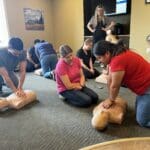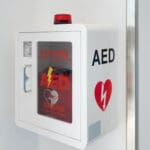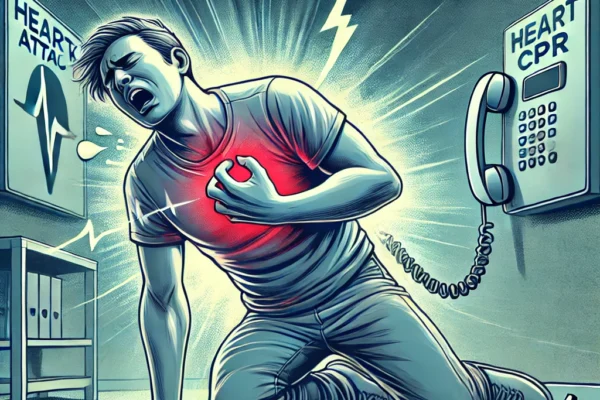Performing CPR can be the difference between life and death in a cardiac emergency. However, it is not uncommon for even trained individuals to make mistakes while administering CPR. These mistakes can significantly reduce the effectiveness of the resuscitation efforts. In this blog, we will discuss the most common mistake made when performing CPR and how to avoid them, ensuring that you are ready to act effectively in an emergency.
Compression-Related Errors
1. Inadequate Compression Depth
One of the most frequent mistakes in CPR is not pushing hard enough. Effective chest compressions need to reach a depth of two inches. This depth is essential to maintain sufficient blood circulation throughout the body. Shallow compressions result in poor blood flow, reducing the chances of a successful outcome.
How to Avoid This Mistake: Aim for a two-inch depth with every compression. Use your body weight to push down firmly, keeping your arms straight to apply the necessary force.
2. Incorrect Compression Rate
CPR must be performed at a rate of 100 to 120 compressions per minute. Compressions that are too slow or too fast can significantly diminish the effectiveness of CPR. A rate that is too slow will not circulate blood efficiently, while one that is too fast can prevent the heart from filling up with blood between compressions.
How to Avoid This Mistake: Use a rhythm to help maintain the correct pace. Many trainers recommend the beat of songs like “Stayin’ Alive” by the Bee Gees, which naturally aligns with the ideal compression rate.
3. Not Allowing Full Chest Recoil
Another common mistake made when performing CPR is not allowing the chest to fully recoil between compressions. When you don’t let the chest return to its normal position, it impedes blood flow back to the heart. This mistake can result from leaning on the victim’s chest during compressions.
How to Avoid This Mistake: After each compression, ensure you fully release the pressure on the chest while keeping your hands in position. This gives the heart a chance to refill with blood.
Positioning Mistakes
4. Incorrect Hand Placement
Proper hand placement is crucial for effective CPR. A frequent error is positioning the hands too low on the chest, often over the upper abdomen rather than the center of the chest. This can decrease the effectiveness of compressions and may cause injury.
How to Avoid This Mistake: Place the heel of one hand in the center of the chest, on the lower half of the breastbone, and place your other hand on top. Interlock your fingers and keep them off the chest.
5. Bending Arms During Compressions
Keeping your arms straight and positioning your shoulders directly over the victim’s chest is vital for applying adequate force. Many rescuers make the mistake of bending their arms, which reduces the power of each compression.
How to Avoid This Mistake: Use your upper body weight to compress the chest by locking your elbows and leaning forward. This ensures that you can apply the necessary force without tiring quickly.
Airway Management Errors
6. Not Tilting the Head Back
Proper airway management is critical during CPR. One common mistake is failing to tilt the head back to open the airway. If the airway remains blocked, air cannot enter the lungs, rendering rescue breaths ineffective.
How to Avoid This Mistake: Before giving rescue breaths, use the head-tilt, chin-lift technique. Gently tilt the head back and lift the chin to open the airway.
7. Over-Inflating the Lungs
When giving rescue breaths, it is easy to over inflate the lungs, especially when anxious. Breaths that are too strong or too prolonged can inflate the stomach instead of the lungs, increasing the risk of vomiting and airway obstruction.
How to Avoid This Mistake: Give slow, gentle breaths just enough to see the chest rise. Each breath should last about one second.
Procedural Errors
8. Delayed CPR Initiation
Time is critical during a cardiac emergency. Delaying CPR reduces the victim’s chance of survival. Yet, many hesitate, either due to fear of doing it incorrectly or waiting for help to arrive.
How to Avoid This Mistake: If someone is unresponsive and not breathing normally, start CPR immediately. Doing something is better than doing nothing.
9. Failure to Summon Emergency Medical Assistance
One of the most significant errors is not calling for emergency help promptly. CPR alone is not sufficient; professional medical intervention is needed as soon as possible.
How to Avoid This Mistake: As soon as you identify an unresponsive person, call 911 or direct someone nearby to do so. If you are alone, use a phone’s speaker function while administering CPR.
10. Interrupting Compressions
Consistent compressions are key to maintaining blood flow. Taking too long of a break between compressions can be disastrous, leading to decreased blood circulation and lower chances of survival.
How to Avoid This Mistake: Limit interruptions to less than 10 seconds. If you need to switch with another rescuer, do so quickly to minimize the break in compressions.
Conclusion
In an emergency, every second counts. Avoiding these common mistake made when performing CPR can significantly improve the chances of survival for someone in cardiac arrest. Remember to maintain the correct compression depth and rate, use proper hand placement, manage the airway correctly, and act promptly. CPR is a critical skill, and practicing it regularly can help you perform it effectively when it matters most.
You can read more this topic here.
Sign up for a training class or contact us for a group quote.




